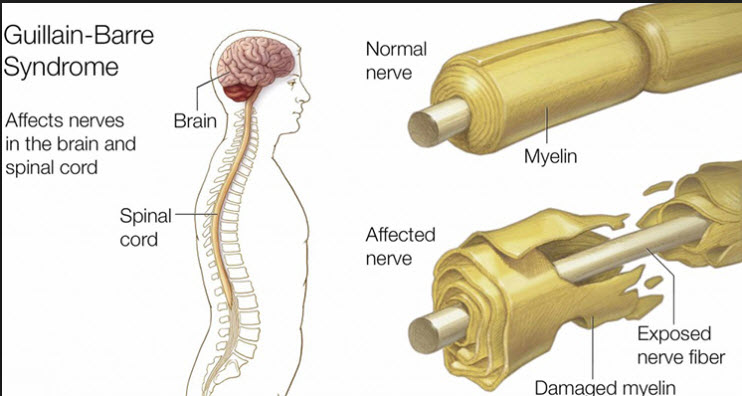
Understanding Guillain-Barre Syndrome: Symptoms, Causes, Diagnosis, and Treatment
Guillain-Barré Syndrome (GBS) is a rare, but potentially life-threatening neurological disorder where the body’s immune system mistakenly attacks the peripheral nervous system. The condition causes sudden muscle weakness, and in severe cases, paralysis. While GBS can affect anyone, it often occurs after an infection, making early diagnosis and treatment essential to improving the chances of recovery.
What is Guillain-Barré Syndrome?
Guillain-Barré Syndrome is a disorder that affects the nerves outside the brain and spinal cord (the peripheral nervous system). In GBS, the immune system, which normally protects the body from infections, attacks the nerves, leading to inflammation and damage. The exact cause of GBS remains unclear, but it is often preceded by a viral or bacterial infection, such as a respiratory or gastrointestinal infection.
The symptoms of GBS typically develop rapidly and can worsen within days or weeks. Early recognition of symptoms is crucial as the condition can progress quickly, sometimes leading to life-threatening complications. However, with prompt medical intervention, the majority of individuals with Guillain-Barré Syndrome can recover, although the recovery process may take several months to a year.
Symptoms of Guillain-Barré Syndrome
The first signs of GBS usually begin with weakness and tingling sensations in the legs, which may spread to the arms and upper body. Common symptoms include:
- Weakness or paralysis: The muscle weakness often starts in the feet and hands and spreads upwards. In severe cases, it can lead to paralysis of the entire body, including the muscles responsible for breathing.
- Tingling or numbness: Many people experience a “pins and needles” sensation in their hands or feet. This sensation may progress and become more intense as the condition worsens.
- Difficulty with movement and coordination: As the muscles weaken, movement becomes increasingly difficult. Patients may have trouble walking or performing everyday tasks.
- Pain and muscle cramps: Some individuals with GBS experience severe pain, especially in the lower back, legs, or arms. The pain may be sharp or cramping in nature.
- Difficulty breathing and swallowing: In severe cases, GBS can affect the muscles involved in breathing, leading to respiratory failure. Difficulty swallowing or speaking may also occur if the muscles controlling the throat are affected.
- Autonomic dysfunction: This refers to issues with the body’s involuntary functions, including heart rate, blood pressure, and digestion. Some people may experience fluctuations in blood pressure or rapid heart rate.
It’s important to note that the progression of GBS can be different for everyone. Some individuals experience mild symptoms, while others may face life-threatening complications, such as difficulty breathing or cardiac arrhythmias.
Causes and Risk Factors
The exact cause of Guillain-Barré Syndrome is still not fully understood. However, researchers believe that it is triggered by an infection that causes the immune system to malfunction and attack the body’s nerves. Some of the most common infections associated with GBS include:
- Respiratory infections: Such as the flu (influenza) and certain types of viral infections like the Epstein-Barr virus.
- Gastrointestinal infections: Caused by bacteria like Campylobacter jejuni, which is one of the most common triggers of GBS.
- Zika virus: In recent years, there has been an increased association between Zika virus infection and Guillain-Barré Syndrome, particularly in regions affected by the virus.
- Other viral infections: Including cytomegalovirus (CMV) and the herpes simplex virus (HSV).
While infections are the most common triggers, GBS has also been linked to vaccinations, surgery, and trauma, although these cases are rare.
Diagnosis of Guillain-Barré Syndrome
Diagnosing Guillain-Barré Syndrome involves a combination of clinical evaluation and diagnostic tests. The doctor will assess the patient’s medical history, including recent infections or illnesses, and conduct a physical examination. The following tests may be used to confirm the diagnosis:
- Nerve conduction studies (NCS): These tests measure the speed of electrical signals in the nerves and can help identify nerve damage caused by GBS.
- Lumbar puncture (spinal tap): A small amount of cerebrospinal fluid (CSF) is collected from the spine to check for elevated protein levels, which can indicate nerve damage typical of GBS.
- Blood tests: While blood tests cannot diagnose GBS directly, they can help rule out other potential causes of the symptoms.
It’s important to consult with a healthcare professional as soon as symptoms of GBS appear, as early diagnosis and treatment are crucial for recovery.
Treatment for Guillain-Barré Syndrome
There is no known cure for Guillain-Barré Syndrome, but there are treatments that can help manage the symptoms and improve the chances of recovery. The main treatment options include:
- Plasma exchange (plasmapheresis): This procedure involves removing harmful antibodies from the blood that are attacking the nervous system and replacing them with donor plasma or a plasma substitute. Plasma exchange is often used in severe cases of GBS.
- Intravenous immunoglobulin (IVIG): IVIG is a treatment that involves infusing healthy antibodies from blood donors to help reduce the abnormal immune response. It is considered a safe and effective treatment for GBS.
- Pain management: Medications such as pain relievers, muscle relaxants, or nerve pain medications may be prescribed to alleviate pain and discomfort.
- Physical therapy: After the acute phase of GBS, physical therapy is essential for helping patients regain strength and function. Rehabilitation programs focus on improving mobility, balance, and coordination.
- Supportive care: In severe cases, patients may require respiratory support, such as mechanical ventilation, if the muscles responsible for breathing are affected.
Prognosis and Recovery
The recovery from Guillain-Barré Syndrome varies from person to person. While some individuals experience a full recovery within several months, others may take a year or longer to regain their strength. The severity of the condition, the speed of diagnosis, and the timeliness of treatment all play a significant role in the recovery process.
It’s important to note that GBS can have long-lasting effects. Some individuals may experience residual weakness or fatigue, even after recovery. In rare cases, GBS can lead to permanent disability or death.
Conclusion
Guillain-Barré Syndrome is a serious condition, but with early diagnosis and treatment, most individuals recover, although the road to recovery may be long. If you or someone you know is experiencing symptoms like muscle weakness, tingling sensations, or difficulty breathing, it’s important to seek medical attention promptly.
With ongoing research and medical advancements, we continue to learn more about Guillain-Barré Syndrome and how to effectively treat it, providing hope for those affected by this condition.



